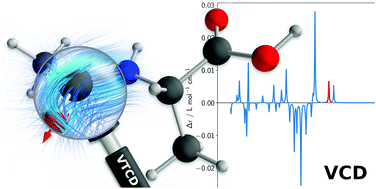Vibrational circular dichroism under the quantum magnifying glass: from the electronic flow to the spectroscopic observable†
Abstract
We present a comprehensive methodology for the analysis and interpretation of vibrational circular dichroism spectra supported by novel graphical representations. The tools rely on the vibrational transition current density (VTCD) associated with a molecular vibration, whose visualization allows exploration of the physical origin of the electronic contribution to the electric and magnetic vibrational dipole transition moments. Different ways of visualizing VTCD from 2D maps to 3D representations are reported and applied to molecular systems of growing complexity. An extension of the VTCD analysis to fully anharmonic spectra within the second-order vibrational perturbation theory (VPT2) is discussed. The analysis is applied to different types of chiral systems: the doubly deuterated oxirane (2S,3S)-oxirane-d2, taken as a reference to validate our implementation; 1,3-difluoroallene, a simple rigid system to explore the application of VTCD to anharmonic VCD spectra. Finally, the analysis of VTCD has been used to better understand the origin of the signal enhancement in peptides linked to the ferrocene groups. The merits and shortcomings of the methods are discussed, and some perspectives for future developments are offered.

- This article is part of the themed collection: 2019 PCCP HOT Articles


 Please wait while we load your content...
Please wait while we load your content...